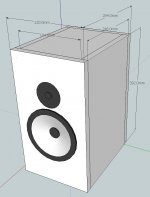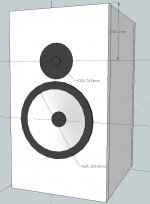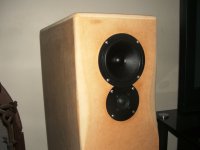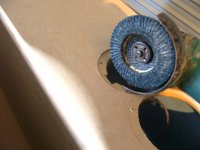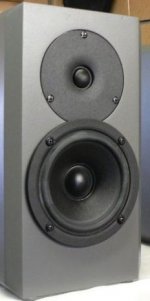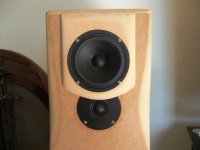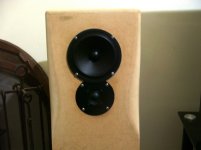Ah yes, I know too well of Murphy.
rabbitz, was just having a good look through your projects site, just had to say: DAMN you've built some speakers.
I love the look of how some of your speaker frames have cropped sides, I doubt that I'll try and do the same this time, but I think it looks very nice.
rabbitz, was just having a good look through your projects site, just had to say: DAMN you've built some speakers.
I love the look of how some of your speaker frames have cropped sides, I doubt that I'll try and do the same this time, but I think it looks very nice.
How does this look for a preliminary box design.
I followed the advice in post 375, it was done very quickly though.
I'm not sure if I have correctly positioned the drivers. I left the centre of the tweeter the same height from the bottom of the box, and then placed the driver fairly close to the tweeter.
Not visible is the port on the rear of the box, 51mm x 174mm as calculated previously in the thread. I will also follow the bracing advice specified, I just haven't shown it in the design as of yet.
The wall thickness is 18mm in the diagram. Internal volume is 16 litres from my calculation. (excluding the space being taken up by internal components)
I have also made the tweeter flush mount into the baffle, where as the woofer is just sitting on top. I have seen many speaker designs that do this but I do not understand why, is it simply a cosmetic decision?
I followed the advice in post 375, it was done very quickly though.
I'm not sure if I have correctly positioned the drivers. I left the centre of the tweeter the same height from the bottom of the box, and then placed the driver fairly close to the tweeter.
Not visible is the port on the rear of the box, 51mm x 174mm as calculated previously in the thread. I will also follow the bracing advice specified, I just haven't shown it in the design as of yet.
The wall thickness is 18mm in the diagram. Internal volume is 16 litres from my calculation. (excluding the space being taken up by internal components)
I have also made the tweeter flush mount into the baffle, where as the woofer is just sitting on top. I have seen many speaker designs that do this but I do not understand why, is it simply a cosmetic decision?
Attachments
I love the look of how some of your speaker frames have cropped sides, I doubt that I'll try and do the same this time, but I think it looks very nice.
It's done by just running the router with a radius bit up the baffle vertical edges. Can be done with an angled bit as well. It's harder to achieve when the box is going to be timber veneered.
How does this look for a preliminary box design.
I followed the advice in post 375, it was done very quickly though.
I'm not sure if I have correctly positioned the drivers. I left the centre of the tweeter the same height from the bottom of the box, and then placed the driver fairly close to the tweeter.
Not visible is the port on the rear of the box, 51mm x 174mm as calculated previously in the thread. I will also follow the bracing advice specified, I just haven't shown it in the design as of yet.
The wall thickness is 18mm in the diagram. Internal volume is 16 litres from my calculation. (excluding the space being taken up by internal components)
I have also made the tweeter flush mount into the baffle, where as the woofer is just sitting on top. I have seen many speaker designs that do this but I do not understand why, is it simply a cosmetic decision?
Looks fine. The tweeter position needs to suit the top of the box so just change the tweeter height from 108 to 86 and the centres between the drivers at 125 max. That should leave about 7mm between the tweeter and woofer flanges and if you want to move them closer or even overlap (have a look at my little grey Raptor speaker) the driver centres reduce accordingly.
I did a sim on my other software and the port can go down to 51 x 144 long.... I don't trust the values from WinISD. Start off at the 174mm and go from there.
Flush mounting the tweeter is the right way to go and flush mounting the woofer is not necessary. Not flush mounting the woofer is easier to build as you don't need to do a rebate but only a hole (make sure the back of the cut out is chamfered as shown in the drawing). It also slightly helps with horizontal offset (driver acoustic centres) but the amount is insignificant but every little bit can help.
If I overlap drivers so I can get closer centres then I don't rebate the woofer as it sits over the tweeter flange by 5mm-15mm.
Last edited:
rebate on the cards
Rebating both, in the overlapped method is exactly what is quite high on my to do list. The P13wh has a very square edge, I can hear the diffraction and its driving me nuts. I thought I might use a flapper disc to rough the tweeter up, then just file and sand it the rest of the way.
Centre to centre here is 110 mm, I was having imaging issues with them which suprised me considering they were so close together, this turned out to be a phase issue.
Mick.
Flush mounting the tweeter is the right way to go and flush mounting the woofer is not necessary. Not flush mounting the woofer is easier to build as you don't need to do a rebate but only a hole (make sure the back of the cut out is chamfered as shown in the drawing). It also slightly helps with horizontal offset (driver acoustic centres) but the amount is insignificant but every little bit can help.
If I overlap drivers so I can get closer centres then I don't rebate the woofer as it sits over the tweeter flange by 5mm-15mm.
Rebating both, in the overlapped method is exactly what is quite high on my to do list. The P13wh has a very square edge, I can hear the diffraction and its driving me nuts. I thought I might use a flapper disc to rough the tweeter up, then just file and sand it the rest of the way.
Centre to centre here is 110 mm, I was having imaging issues with them which suprised me considering they were so close together, this turned out to be a phase issue.
Mick.
Attachments
Last edited:
I'd be very surprised if that edge is causing enough diffraction issues that would drive you nuts. You can place some high density foam on the edge of the P13 to see if it is the cause. Speaker gasket self adhesive dense foam can work well.
Have a look at some info on steps here:
Troelsgravesen stepped baffle
Dynaudio as well as other manufacturers have done this for years without drama. I have a little P11 speaker with 102mm driver centres and have noticed no ill effects.
We can be sensitive to sonic issues that doesn't bother others such as hum and buzz.
Have a look at some info on steps here:
Troelsgravesen stepped baffle
Dynaudio as well as other manufacturers have done this for years without drama. I have a little P11 speaker with 102mm driver centres and have noticed no ill effects.
We can be sensitive to sonic issues that doesn't bother others such as hum and buzz.
Attachments
Agreed, I don't dispute it being a right or wrong method, it's not for me to say what someone else is hearing.
I can and do hear it, and it drives me nuts, that part of it is not up for discussion!
The fact seems to be that few seem to notice, but I sure do.
I did trick up that edge, instant results, (for me, FWIW).
I had tried these methods well before posting, IME, the sharp edge is not for everyone, however I absolutely agree with the overlapping for C2C purposes.
This is different to saying its not a good method or its just plain right.
Again FWIW, hum and buzz don't seem to upset my listening experience at all. But again, I hardly hear them ( except, eg, that one in Billy joel's "For the longest time", what is that? An old valve circuit buzz? Anyway, to me even thats only, 'there'). But I do seem to be overly sensitive to 'ringing', at certain frequency's, (not the tinnitus one, YET.), and hissed eSSes.
I honestly think it's a 'try it and see', thing, as I just assumed it would drive everybody just as nuts. Thanks for opening my eyes/ears.
Once I have done this job, right or wrong, I will post MY listening (subjective) results here.
I have seen your previous projects and I love the way you have gone about them, I wouldn't dare challange your methods or results, but, for now, as far as this particular issue goes, and with all due respect, I hate to disagree.......but, I know what 'I' hear.
Regards, Mick.🙂
I can and do hear it, and it drives me nuts, that part of it is not up for discussion!
The fact seems to be that few seem to notice, but I sure do.
I did trick up that edge, instant results, (for me, FWIW).
I had tried these methods well before posting, IME, the sharp edge is not for everyone, however I absolutely agree with the overlapping for C2C purposes.
This is different to saying its not a good method or its just plain right.
Again FWIW, hum and buzz don't seem to upset my listening experience at all. But again, I hardly hear them ( except, eg, that one in Billy joel's "For the longest time", what is that? An old valve circuit buzz? Anyway, to me even thats only, 'there'). But I do seem to be overly sensitive to 'ringing', at certain frequency's, (not the tinnitus one, YET.), and hissed eSSes.
I honestly think it's a 'try it and see', thing, as I just assumed it would drive everybody just as nuts. Thanks for opening my eyes/ears.
Once I have done this job, right or wrong, I will post MY listening (subjective) results here.
I have seen your previous projects and I love the way you have gone about them, I wouldn't dare challange your methods or results, but, for now, as far as this particular issue goes, and with all due respect, I hate to disagree.......but, I know what 'I' hear.
Regards, Mick.🙂
Oh no, you aren't going to like my MTM's then Mick 😉 both woofers are surface mounted (though I will get around to some felt on the baffle one of these days). I know what you mean about hissed esses too, I ended up padding the tweeter down probably about 2db more than flat to tame it. Though interestingly I've read many saying that the amp (rather than the speakers) can be the cause of this. I've also wondered if a resonant peak filter on the tweeter might help, or going to a higher slope filter.
I was worried about diffraction effects, but decided I'd take that compromise in order to have time alignment. I did try flush mounting the woofers and deep rebating the tweeter (with a flare) to keep the time alignment, but the diffraction effects of that were MUCH worse than anything the woofers were contributing when surface mounted!
All that said I have read that even the heads of the screws holding in the tweeters can have an effect.
Unfortunately I do suffer from tinitus. sometimes sounds like there are cicada's in the room, sometimes much higher freq's probably 15K or higher, the really funny thing is I can't actually hear past 13K!! but the ringing in my ears is definitely higher in pitch than that....
Tony.
I was worried about diffraction effects, but decided I'd take that compromise in order to have time alignment. I did try flush mounting the woofers and deep rebating the tweeter (with a flare) to keep the time alignment, but the diffraction effects of that were MUCH worse than anything the woofers were contributing when surface mounted!
All that said I have read that even the heads of the screws holding in the tweeters can have an effect.
Unfortunately I do suffer from tinitus. sometimes sounds like there are cicada's in the room, sometimes much higher freq's probably 15K or higher, the really funny thing is I can't actually hear past 13K!! but the ringing in my ears is definitely higher in pitch than that....
Tony.
OK lets get this straight, my all time favorite commercial speaker does use the woofers surface mounted and the tweeter flush mounted.
You must understand from this, that I don't have anything against the idea. In certain applications, ie, mine, there is a VERY noticeable difference, to my ears this is a simple fact.
The fact is, if I smooth that out, they do sound ALOT better. My favs are also mtms, just like yours Tony. So I guess there is plenty to suggest they won't sound good to me based on that alone.
I do not pretend to know the exact science behined this, some do, some don't, sound better, sorry, gonna stand my ground on this one!🙂
Cheers, Mick.
You must understand from this, that I don't have anything against the idea. In certain applications, ie, mine, there is a VERY noticeable difference, to my ears this is a simple fact.
The fact is, if I smooth that out, they do sound ALOT better. My favs are also mtms, just like yours Tony. So I guess there is plenty to suggest they won't sound good to me based on that alone.
I do not pretend to know the exact science behined this, some do, some don't, sound better, sorry, gonna stand my ground on this one!🙂
Cheers, Mick.
Not questioning you Mick 😉 and I suspect that measurements would more than likely show what it is that you are finding offensive, I strongly believe that different people are more sensitive to different errors in reproduction. This is why I personally don't believe that measurements can tell you everything (or give you a generic this will be liked by everyone).
Every persons ear shape is different, and their brains have been wired to process the sounds it recives differently as well. Some ears may cause certain anomylies to be amplified others may not even hear it. A visual parallel is monitor flickr (on crt's) I'm particularly sensitive to it and can't stand a monitor with a refresh rate lower than 85Hz whereas I've been to peoples desks who have their monitor sitting on 60Hz which drives me crazy and I ask them doesn't the flickr bother them, and they respond that they can't see any flickr. I Change the refresh rate back and forth, and they can't see any difference!!
Tony.
Every persons ear shape is different, and their brains have been wired to process the sounds it recives differently as well. Some ears may cause certain anomylies to be amplified others may not even hear it. A visual parallel is monitor flickr (on crt's) I'm particularly sensitive to it and can't stand a monitor with a refresh rate lower than 85Hz whereas I've been to peoples desks who have their monitor sitting on 60Hz which drives me crazy and I ask them doesn't the flickr bother them, and they respond that they can't see any flickr. I Change the refresh rate back and forth, and they can't see any difference!!
Tony.
Tony has given a good suggestion with felt and you can apply that on the tweeter faceplate.
I hate 50Hz hum in amps as well as the hum/buzz on some fluros. We all have our triggers.
The P13 can have some nasties if crossed over too high but I'm not saying it's happening in your case.
I hate 50Hz hum in amps as well as the hum/buzz on some fluros. We all have our triggers.
The P13 can have some nasties if crossed over too high but I'm not saying it's happening in your case.
Thanx guys, I'm sorry to drive that point home so hard, but when you know beyond doubt, what your hearing and its cause is not your imagination, no pretty coloured lines can tell you otherwise.
You are definately right on alot of points as well, not least of which, what some people hear that others simply don't. As you point out Tony, what some see that others don't.
If I may, the diffraction I hear is quite similar to listening at reference levels, with a flouro in the room, you don't hear the flouro as such, but it is instantly cleaner sounding the second its turned off. It detracts from experience, more than it can be straight out heard as such.
You know instantly when that tube has been switched back on, it's that exact same kind of 'drives me nuts', although I do find the flouro a bit easier to put up with. Your reference to the flouro was a good one to help me explain that.
The P13 does indeed have some nasties up there, I have mine crossed at around 200 and 2.2k. I found a passive BSC circuit helped tame those esses as well, this maybe a no-no for an active system, but it works for me, shaping is beneficial at times, again not everyones cup of tea.
I have tried various things to tame it down, some more successful than others. Rabbitz, your link has given me a better solution than cutting the tweeter up. I should be able to time align the drivers with a piece of 12mm mdf and the p13 recessed into that. If I can get the surfaces to mould together organically enough, I think it will help the diffraction situation as well. Two birds with one stone.
At the moment I have a major issue with these speakers having a very narrow sweet spot. Actually its more than that, moving from side to side slightly, I'm talking mere cm's here, strongly favours one channel over the other, especially Hi-Hats, I think this could be related to lack of time alignment (i'm hoping, at least).
I apologise for being so blunt, but I needed anyone to know that I do hear it, before they start posting plots that tell me that I don't, as I feel there is nothing worse and find it almost insulting.
Cheers guys and thanks again,
Mick.🙂
You are definately right on alot of points as well, not least of which, what some people hear that others simply don't. As you point out Tony, what some see that others don't.
If I may, the diffraction I hear is quite similar to listening at reference levels, with a flouro in the room, you don't hear the flouro as such, but it is instantly cleaner sounding the second its turned off. It detracts from experience, more than it can be straight out heard as such.
You know instantly when that tube has been switched back on, it's that exact same kind of 'drives me nuts', although I do find the flouro a bit easier to put up with. Your reference to the flouro was a good one to help me explain that.
The P13 does indeed have some nasties up there, I have mine crossed at around 200 and 2.2k. I found a passive BSC circuit helped tame those esses as well, this maybe a no-no for an active system, but it works for me, shaping is beneficial at times, again not everyones cup of tea.
I have tried various things to tame it down, some more successful than others. Rabbitz, your link has given me a better solution than cutting the tweeter up. I should be able to time align the drivers with a piece of 12mm mdf and the p13 recessed into that. If I can get the surfaces to mould together organically enough, I think it will help the diffraction situation as well. Two birds with one stone.
At the moment I have a major issue with these speakers having a very narrow sweet spot. Actually its more than that, moving from side to side slightly, I'm talking mere cm's here, strongly favours one channel over the other, especially Hi-Hats, I think this could be related to lack of time alignment (i'm hoping, at least).
I apologise for being so blunt, but I needed anyone to know that I do hear it, before they start posting plots that tell me that I don't, as I feel there is nothing worse and find it almost insulting.
Cheers guys and thanks again,
Mick.🙂
Looks fine. The tweeter position needs to suit the top of the box so just change the tweeter height from 108 to 86 and the centres between the drivers at 125 max. That should leave about 7mm between the tweeter and woofer flanges and if you want to move them closer or even overlap (have a look at my little grey Raptor speaker) the driver centres reduce accordingly.
I did a sim on my other software and the port can go down to 51 x 144 long.... I don't trust the values from WinISD. Start off at the 174mm and go from there.
Flush mounting the tweeter is the right way to go and flush mounting the woofer is not necessary. Not flush mounting the woofer is easier to build as you don't need to do a rebate but only a hole (make sure the back of the cut out is chamfered as shown in the drawing). It also slightly helps with horizontal offset (driver acoustic centres) but the amount is insignificant but every little bit can help.
If I overlap drivers so I can get closer centres then I don't rebate the woofer as it sits over the tweeter flange by 5mm-15mm.
Cool thanks.
I've moved the tweeter up to the correct position, I'm just looking at pictures trying to determine whether I like the look of having the woofer overlapping the tweeter flange, otherwise I'll place them so that their centres are no further than 125mm apart.
I didn't even pick up the chamfer on the inside of the woofer cut out, thanks for pointing that out.
OK, I have recessed the p13 into this piece of 12 mm mdf as per link, (Thanks Rabbitz). Physical alignment is much, much closer. Basicly, I've tried to limit the amount of diffraction sources focusing on any particular freq. whilst keeping a close centre to centre, and as close as possible pysical alignment.
Alot less sound smearing, some sounds that were only there before are now pin sharp, sounds like you could fit a heap more sounds into each tiny piece and there's tonnes of room left over.
The diffraction I was hearing is less annoying now, it's not gone, in fact, if anything off axis at some angles its a little worse I think, but better overall.
I think what I was hearing, was the rim of the p13, coloring it's own sound rather than the sounds from the tweeter.
The biggest difference? Those hissing esses are much, much smoother, If anything can trip up a pair of otherwise nice sounding speakers, to my ears, those damned esses will do it.
This modification has improved that side of it out of sight, so for me they sound FAR more natural.
What can I say, I reckon they look better to boot!
Cheers Mick.🙂
Alot less sound smearing, some sounds that were only there before are now pin sharp, sounds like you could fit a heap more sounds into each tiny piece and there's tonnes of room left over.
The diffraction I was hearing is less annoying now, it's not gone, in fact, if anything off axis at some angles its a little worse I think, but better overall.
I think what I was hearing, was the rim of the p13, coloring it's own sound rather than the sounds from the tweeter.
The biggest difference? Those hissing esses are much, much smoother, If anything can trip up a pair of otherwise nice sounding speakers, to my ears, those damned esses will do it.
This modification has improved that side of it out of sight, so for me they sound FAR more natural.
What can I say, I reckon they look better to boot!
Cheers Mick.🙂
Attachments
Cool thanks.
I've moved the tweeter up to the correct position, I'm just looking at pictures trying to determine whether I like the look of having the woofer overlapping the tweeter flange, otherwise I'll place them so that their centres are no further than 125mm apart.
Just stick with the 125mm centres and all will be cool.
Just an update.
I still haven't had a chance to start building and I most likely won't till the end of the semester. Of the >3 years that I have been at uni, this semester would have to have the heaviest work load of all of them. Either that or I have just lost motivation due to some very dry subjects I am currently enrolled in.
I am still very much looking forward to getting into this project and everyone's advice has not gone to waste.
I still haven't had a chance to start building and I most likely won't till the end of the semester. Of the >3 years that I have been at uni, this semester would have to have the heaviest work load of all of them. Either that or I have just lost motivation due to some very dry subjects I am currently enrolled in.
I am still very much looking forward to getting into this project and everyone's advice has not gone to waste.
Just hang in there Nipper and tackle it when you can, I haven't started my next speaker yet either
- Status
- Not open for further replies.
- Home
- Loudspeakers
- Multi-Way
- Kit in Australia
